Co-organized with the National Art Gallery, Singapore and set to tour in National Museum of Contemporary Art, Korea and National Art Gallery, Singapore, Realism in Asian Art is the first exhibition ever in Korea to present 104 modern art masterpieces from ten Asian countries including Korea, China, Japan, Singapore, Malaysia, Indonesia, Thailand, Vietnam, Philippines and India.
The exhibition presents various layers in the discourses of 'Realism', from the introduction of Realism to Asia through the contact with the West at the end of 19th century as a form of 'representation', to the penetration of the turbulent and chaotic Asian history of 20th century and establishment of consciousness about the self, others and "reality".
THEME 1: Realism as a Form of Representation
At the end of 19th century and early 20th century, most Asian countries were colonized by the West and accepted their new and modern 'techniques' which allowed for the three-dimensional representation of objects in painting. Such novelty can be seen in the detailed portraits and landscape paintings that apply a single-point perspective. 'Realism' at the time was understood as an artistic technique to transfer visual experiences 'as they were' onto two-dimensional surfaces. At the same time, artists also attempted a synthesis of their own artistic conventions with those from the West.
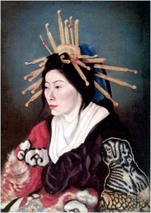
Takahashi Yuichi is an early modern painter in Japan. While working in the Painting Department at the Institute for the Study of Barbarian Books, he became interested in Western oil painting. He later learned to paint with English artist Charles Wirgman and Italian painter Antonio Fontanesi, and his famous still life painting Salmon illustrates his attempt at a realist depiction. Another famed painting Courtesan on display in this exhibition, is a portrait of an Oiran, the highest ranking courtesan of the pleasure quarters. She is shown here in traditional dress with the Yoko-hyogo hairstyle, typically seen in nishiki-e or traditional Japanese coloured woodcuts. Both paintings are revered as Important Cultural Properties of Japan.
THEME 2: The Countryside as an Attitude and Metaphor
In the first half of the 20th century during the colonial period, the notion of 'ethnicity' surfaced in many Asian countries. The harsh reality of life in rural communities of these agrarian-based countries became the subject of nostalgia and aspiration. Such idealized depictions of the rural, however, could not avoid the criticism that it provided a means of escape from reality. Nevertheless, the genuine artistic concern for the nature and environment of their own surroundings demonstrated the bitter efforts of those artists who sought their ethnicity despite structural obstacles. It is in this respect that this theme has remained popular in Asia for a long time.
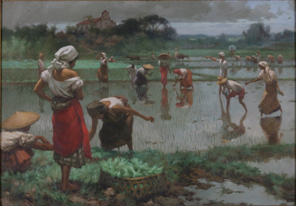
Fernando Amorsolo, a National Artist, first trained under the celebrated Filipino artist Fabian de la Rosa who was his older cousin. He later finished a five-year degree course from the University of the Philippines School of Fine Arts, and travelled to Spain and France under a private grant. There at the museums, he encountered European masterpieces that had a profound influence on his art practice. He later came to be known for his distinct style of depicting idyllic rural scenes, town folks, rural maidens, and landscapes under the warm tropical sun. This is exemplified in Rice Planting of a scene set against a panoramic background. The painting's treatment is tended towards idealizing the scene rather than depicting the farmers as "labourers of the earth."
THEME 3: 'Hail the Worker!'
The depiction of the working class and the underprivileged is a new phenomenon considering the past artistic practices of Asia. After the Russian Revolution in 1917 and especially during the 1920s to the 1940s, Asian countries witnessed a prevailing trend that art ought to be associated with the lives of street beggars, workers, farmers and ordinary people. This consciousness was further exaggerated in Communist countries like China after the Second World War. The heroization of the worker image continued, negating the class distinction itself between laborers, farmers, artists and intellectuals.
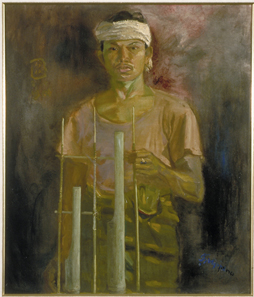
Sudjojono was a student of the realist painter Mas Pirngadie and visiting Japanese artist Chiyoji Yazaki. Along with other Indonesian artists, he founded the Union of Indonesian Painters or PERSAGI, aimed at invigorating Indonesian art that was then dominated by the romantic landscapes of the Beautiful Indies style. According to Sudjojono, Indonesian painters should reflect the social reality of their environment. Angklung Player demonstrates his vision. The angklung is a musical instrument used in agricultural festivals as well as in arousing the fighting spirit of soldiers during war time. This portrait is therefore a reflection of the Indonesian working class who contributed towards the shaping of Indonesian national identity.
THEME 4: The Impact of War
One of the most decisively influential realities that challenged Asian countries in the 20th century was that they were in the midst of great wars. Peace did not return even after the Second World War ended, as various large and small wars - such as Indonesian struggle for independence, the Korean War and the Vietnam War - continued to plague the region. As an easily understood art form, a realist approach was popular in the creation of war paintings as such works were deemed suitable for not only as documentations of combat activities but also in informing the public about adversities and, as propaganda, in celebrating victories.
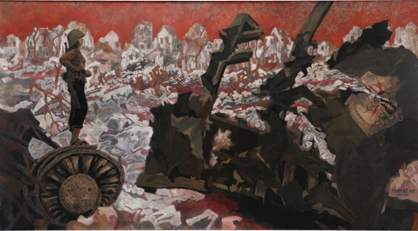
Phan Ke An was accepted into the Indochina School of Fine Arts but he did not complete his studies due the outbreak of the Independence war with France. Besides being a talented painter, he is renowned to be the only artist commissioned to paint the portrait of the Premier Ho Chi Minh. A nationalist at heart, he painted Hanoi Christmas Bombing of 1972, 10 years after the incident. The bombing was carried out in retaliation against North Vietnam for the breakdown in peace talks. Drawing attention to the widespread destruction of the city, he depicted a female figure standing majestically over the ruins. Her upright figure adds an emotive aspect to the painting evoking the pride and resilience of the Vietnamese people.
THEME 5: Social Criticism and Outcry: Towards a New Realism
Most Asian countries had gained independence by the latter half of 20th century, but the surviving colonial social structure, political corruption and ideological conflicts stirred various artistic issues in the artists as intellectuals. Abstract art became 'institutionalized' in the 1950s and 1960s in most Asian countries except for communist states. However in the 1970s, discourses of 'realism' took a new turn and re-surfaced in countries like South Korea, Philippines, Thailand and Indonesia. A 'New Realism' emerged as a basis for artistic expressions of social criticism and outcry.
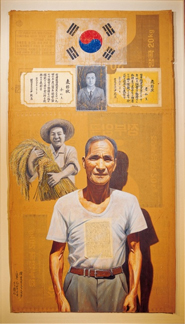
A proponent of the Minjung or People's art movement, Lee Jong-gu is a graduate of Chung-Ang University and Inha University. He came to be known as a painter of radical changes that took place in rural areas during the 1980s. Sequel - Agriculture Forms the Basis of the World's Existence is a criticism levied against those who discount the traditional saying that agriculture is the basis of life. Painted on the back of a rice bag, the realist portrait of a lean aging farmer is starkly compared with a collaged advertisement of a beaming farmer hugging a bushel of rice stalks in his arms.
